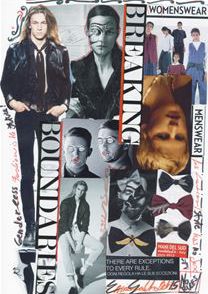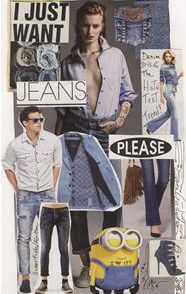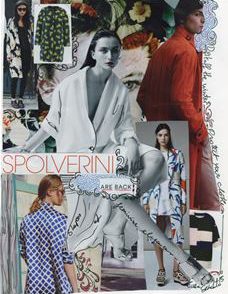After a long ‘Christmas break,’ it is a pleasure to write my Style and the City column again! In these months I’ve had the chance to attend two important events in Italian fashion: the Pitti Filati trade fair last Janaury in Florence, which forecasted trends and textiles for the 2011 spring/summer collections, and the Milan fashion week last February, which presented Italy’s top 2010/2011 fall/winter ready-to-wear collections.
Attending these two unique events prompted a series of deep reflections on the Made in Italy label: its current state and its future in the international fashion market.
Milan. On February 24, I went to the first day of the Milano Moda Donna fashion shows. The red carpet was lined with photographers, models, glamourous TV personalities and eager fashionistas. As every six months, when the shows are held, everyone in Milano Moda Donna was waiting with baited breath for the start of the runway spectacle.
However, though it was my first time at Milano Moda Donna, I immediately felt a strange atmosphere, a sort of subtle sadness in the air, made of fake yet perfect smiles that were trying to hide a clear sense of worry. As I always tell my students, particularly today, during the current global economic crisis, ‘fashion reflects what happens in society and society reflects what happens in fashion.’ On the first day of the shows, it was evident that all of the people in attendance-the designers, the buyers, the press, and even the president of the Camera Nazionale della Moda Italiana, Mario Boselli-were celebrating a bi-annual ritual that was suddenly much less believable than it used to be.
The first shock was the bankruptcy scandal of the Milan-based fashion house Mariella Burani, one of the top names in Italian fashion. Then, just 15 days before the official start of Milan’s fashion week, Anna Wintour, the editor-in-chief of Vogue America, made a rather successful attempt to devastate the Milan fashion show calendar to fit her personal needs.
It’s no secret that the powerful and devastating ‘Hurricane Anna,’ the real-life inspiration of the evil boss in the Hollywood blockbuster, The Devil Wears Prada, decided that the ‘devil’ would continue to wear Prada only if Milan’s runway shows this season were packed into three days, instead of the regular seven.
Whereas Paris courageously resisted Wintour’s intimidation attempts, Milan weakly bended to the power of the U.S. fashion market, and pretty much gave in to the ‘devil.’ With the exception of Fendi and Prada, who kept to their original calendar dates, all the big names in Italian fashion succumbed to Wintour’s wishes and changed their schedules, leading to over 15 shows a day over just three days, and the eventual cancellation of the last two days of Milano Moda Donna.
As if that wasn’t enough, after I had attended a series of interesting shows by young and upcoming designers, called Next Generation and NUDE, I was unexpectedly invited to a bizarre runway spectacle: the show of the new collection, Seduzioni Diamonds, designed by the television showgirl Valeria Marini. Over the runway a huge TV screen projected the most famous images of the Federico Fellini’s La Dolce Vita; however the bright lights and loud music transformed this unforgettable cinema masterpiece into a sort of disco experience. Meanwhile, Marini’s Barbie-like models strutted their stuff up and down the catwalk, wrapped in lace and velvet corset dresses, embellished with hundreds of beads.
The whole experience was shocking. Will the future Italian fashion be relegated to a re-packaging of Italian stereotypes like the Vespa, voluptuous and sexy females and even the colors of our national flag? Is there a lack of true inspiration and creative flair in Italy? Luckily, I realized that young designers like Susanna Cornet, Francesco di Giorgi, Cristiano Burani, Chicca Lualdi, who are struggling to find a space in an ever more restricted fashion Olympus, are offering a more interesting, creative vision of Italian style and fashion.
In addition to discovering these young designers, I was happy to see that some illustrious, historic brands, like Moschino, have continued to churning out original and ironic interpretations of the current world. Take, for example, Moschino’s very popular Smash the fashion system! campaign, launched in the 90s; today, many years after the death of the house’s great founder, it has window displays, showing a Moschino-clad woman at a bank machine while the floor is covered with a type of Monopoly money with the writing ‘love is free.’ Chapeau, hats off to Moschino!
A suggestion: while you are in Florence buy something in leather; it’s the top material for next fall.
Florence. In late January, Pitti Filati portrayed this same kind of duality: a mix of innovation and re-visited clichés. Considered one of the top events in the global fashion industry, the fair is just one of the many events held in Florence by Pitti Immagine and it is an important example of Florence’s vital role in the Italian fashion system. A role that the city has had since the Renaissance (see ‘Florence: the art of fashion’ in TF 88.)
Pitti Filati hosted a special preview, called Prima Moda Tessuto, and I was disappointed to see that the excellence of Italian fabrics were presented under clichéd names like Naples, Pompeii, and Capri. A table in this section of the fair reproduced the colors of the Italian flag, using tomatoes, mozzarella cheese and basil, just like your run-of-the-mill pizzeria. Mamma mia, more re-pacakaged stereotypes! However, the Pitti Filati’s main trend forecast area called ‘No’, which stands for ‘no washing machine, No supermarket, no email, no restaurant, no car’ was surprising and extremely refreshing.
A spot-on and compelling interpretation of our difficult times was also exemplified by a section on how the ‘frivolous’ fashion world considers green issues. Eco-fashions are an extremely important reality today, because, after all, ‘fashion reflects what happens in society …’ I believe that we shouldn’t forget our illustrious past, but instead use it as the basis to create a new kind of cutting-edge Italian style!
Coming up: more on the state of ‘green’ fashions in Italian style!







